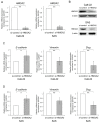HMGA2 Contributes to Distant Metastasis and Poor Prognosis by Promoting Angiogenesis in Oral Squamous Cell Carcinoma
- PMID: 31109142
- PMCID: PMC6566167
- DOI: 10.3390/ijms20102473
HMGA2 Contributes to Distant Metastasis and Poor Prognosis by Promoting Angiogenesis in Oral Squamous Cell Carcinoma
Abstract
The highly malignant phenotype of oral squamous cell carcinoma (OSCC), including the presence of nodal and distant metastasis, reduces patient survival. High-mobility group A protein 2 (HMGA2) is a non-histone chromatin factor that is involved in advanced malignant phenotypes and poor prognosis in several human cancers. However, its biological role in OSCC remains to be elucidated. The purpose of this study was to determine the clinical significance and role of HMGA2 in the malignant potential of OSCC. We first investigated the expression pattern of HMGA2 and its clinical relevance in 110 OSCC specimens using immunohistochemical staining. In addition, we examined the effects HMGA2 on the regulation of vascular endothelial growth factor (VEGF)-A, VEGF-C, and fibroblast growth factor (FGF)-2, which are related to angiogenesis, in vitro. High expression of HMGA2 was significantly correlated with distant metastasis and poor prognosis. Further, HMGA2 depletion in OSCC cells reduced the expression of angiogenesis genes. In OSCC tissues with high HMGA2 expression, angiogenesis genes were increased and a high proportion of blood vessels was observed. These findings suggest that HMGA2 plays a significant role in the regulation of angiogenesis and might be a potential biomarker to predict distant metastasis and prognosis in OSCC.
Keywords: HMGA2; angiogenesis; metastasis; oral squamous cell carcinoma; prognosis.
Conflict of interest statement
The authors declare no conflict of interest. The funders had no role in the design of the study; in the collection, analyses, or interpretation of data; in the writing of the manuscript, or in the decision to publish the results.
Figures







Similar articles
-
High HMGA2 Expression Correlates with Reduced Recurrence-free Survival and Poor Overall Survival in Oral Squamous Cell Carcinoma.Anticancer Res. 2017 Apr;37(4):1891-1899. doi: 10.21873/anticanres.11527. Anticancer Res. 2017. PMID: 28373457
-
Prediction of outcome of patients with oral squamous cell carcinoma using vascular invasion and the strongly positive expression of vascular endothelial growth factors.Oral Oncol. 2011 Jul;47(7):588-93. doi: 10.1016/j.oraloncology.2011.04.013. Epub 2011 May 23. Oral Oncol. 2011. PMID: 21602095
-
Expression of AEG-1 and microvessel density correlates with metastasis and prognosis of oral squamous cell carcinoma.Hum Pathol. 2014 Apr;45(4):858-65. doi: 10.1016/j.humpath.2013.08.030. Epub 2014 Jan 8. Hum Pathol. 2014. PMID: 24656097
-
Effects of Angiogenic Factors on the Epithelial-to-Mesenchymal Transition and Their Impact on the Onset and Progression of Oral Squamous Cell Carcinoma: An Overview.Cells. 2024 Jul 31;13(15):1294. doi: 10.3390/cells13151294. Cells. 2024. PMID: 39120324 Free PMC article. Review.
-
Oral squamous cell carcinoma: metastasis, potentially associated malignant disorders, etiology and recent advancements in diagnosis.F1000Res. 2020 Apr 2;9:229. doi: 10.12688/f1000research.22941.1. eCollection 2020. F1000Res. 2020. PMID: 32399208 Free PMC article. Review.
Cited by
-
HMGA2 as a Critical Regulator in Cancer Development.Genes (Basel). 2021 Feb 13;12(2):269. doi: 10.3390/genes12020269. Genes (Basel). 2021. PMID: 33668453 Free PMC article. Review.
-
Screening and functional prediction of differentially expressed circRNAs in proliferative human aortic smooth muscle cells.J Cell Mol Med. 2020 Apr;24(8):4762-4772. doi: 10.1111/jcmm.15150. Epub 2020 Mar 10. J Cell Mol Med. 2020. PMID: 32155686 Free PMC article.
-
Genes involved in metastasis in oral squamous cell carcinoma: A systematic review.Health Sci Rep. 2024 Apr 24;7(4):e1977. doi: 10.1002/hsr2.1977. eCollection 2024 Apr. Health Sci Rep. 2024. PMID: 38665153 Free PMC article.
-
Histone lysine methyltransferase SMYD3 promotes oral squamous cell carcinoma tumorigenesis via H3K4me3-mediated HMGA2 transcription.Clin Epigenetics. 2023 May 26;15(1):92. doi: 10.1186/s13148-023-01506-9. Clin Epigenetics. 2023. PMID: 37237385 Free PMC article.
-
High mobility group A2 (HMGA2) protein tissue levels and its association with clinicopathological features in bladder cancer patients.Discov Oncol. 2025 Aug 25;16(1):1622. doi: 10.1007/s12672-025-03462-7. Discov Oncol. 2025. PMID: 40853523 Free PMC article.
References
MeSH terms
Substances
Grants and funding
LinkOut - more resources
Full Text Sources
Medical

